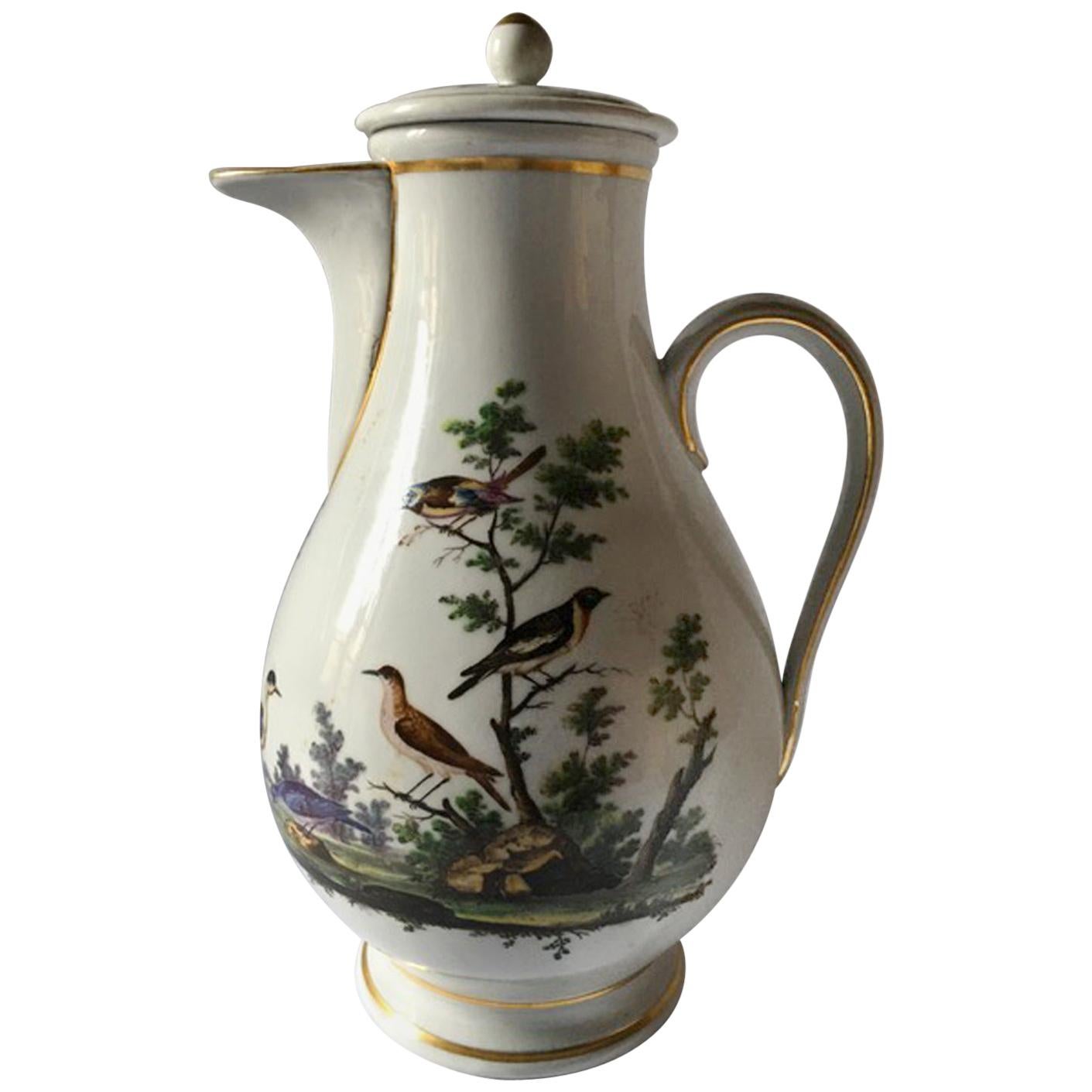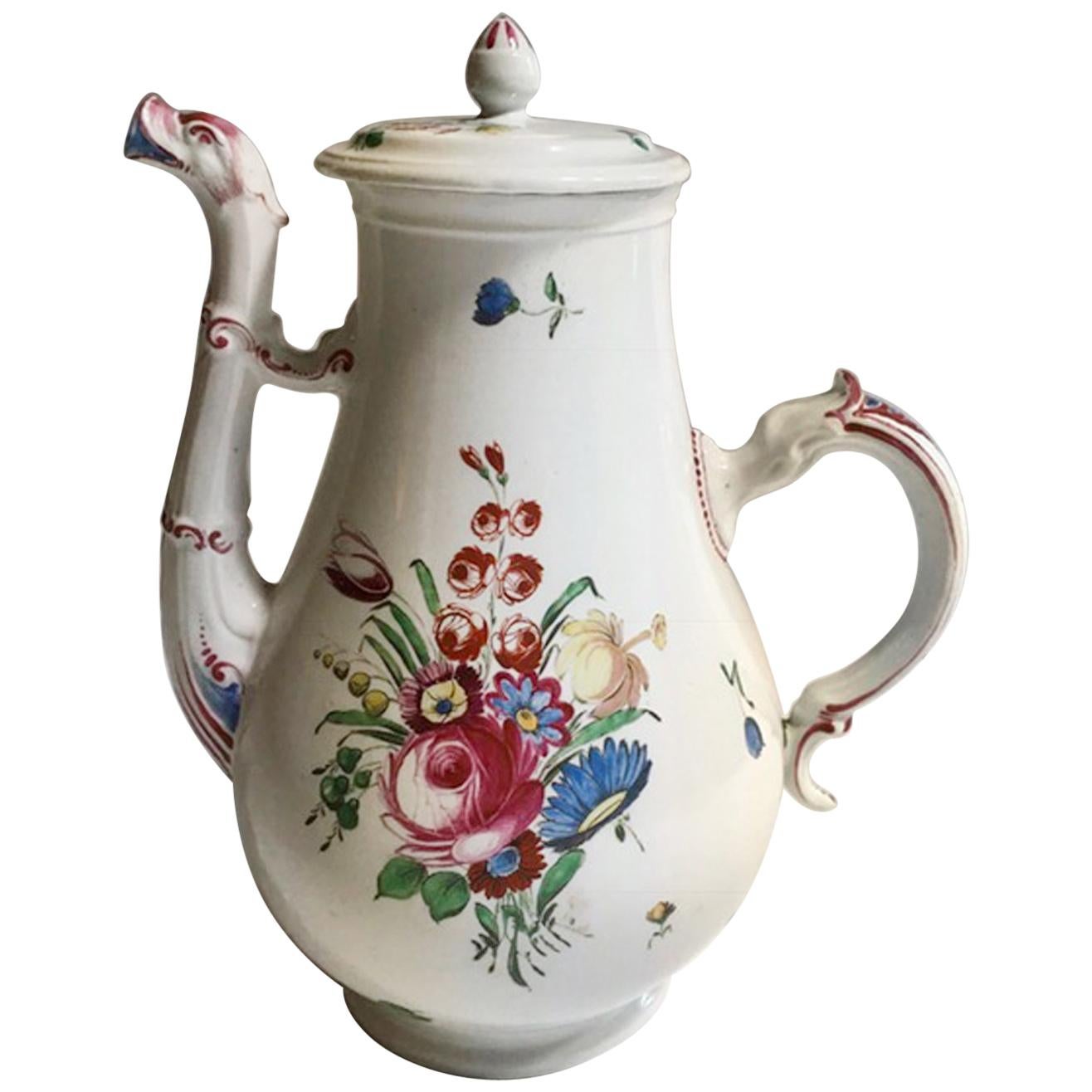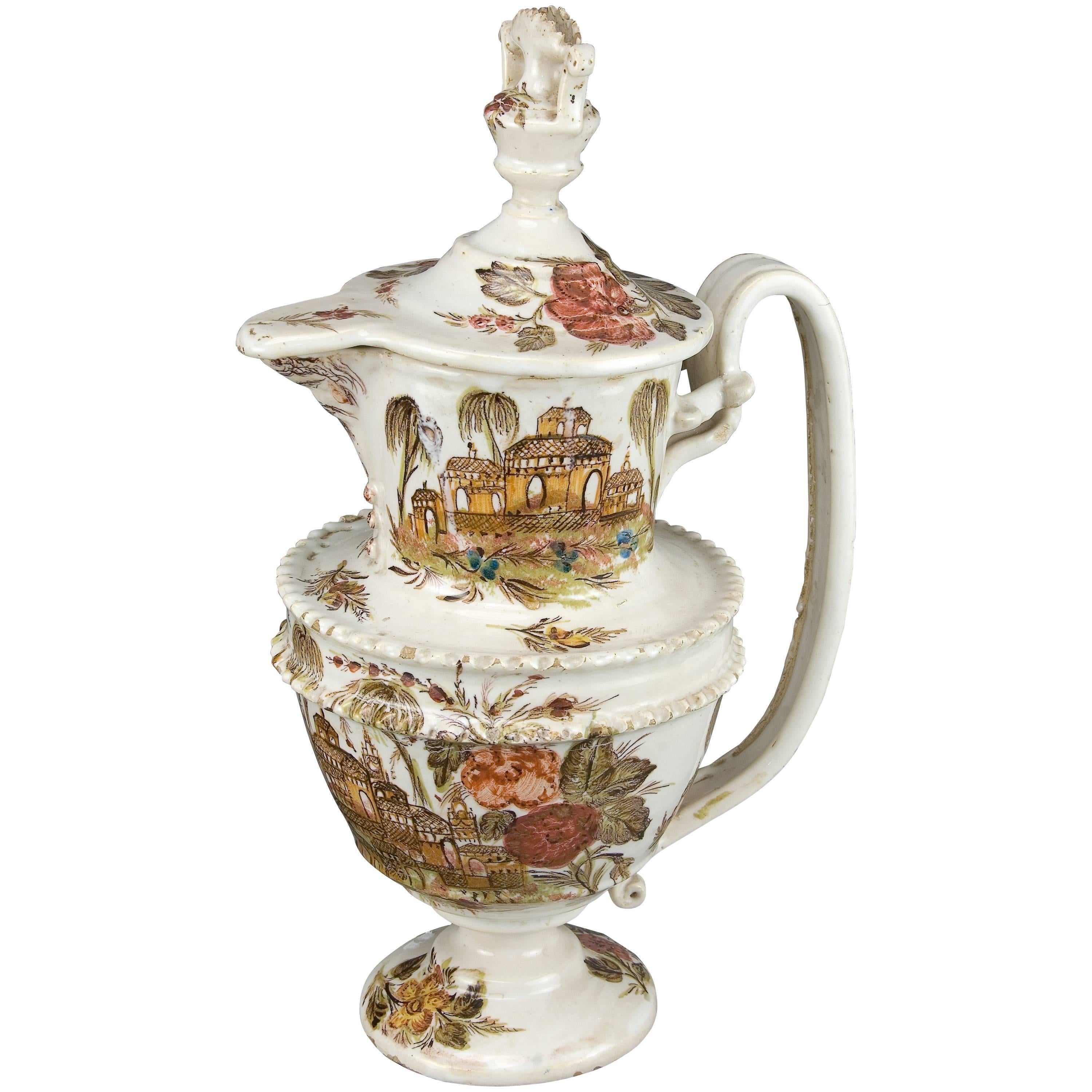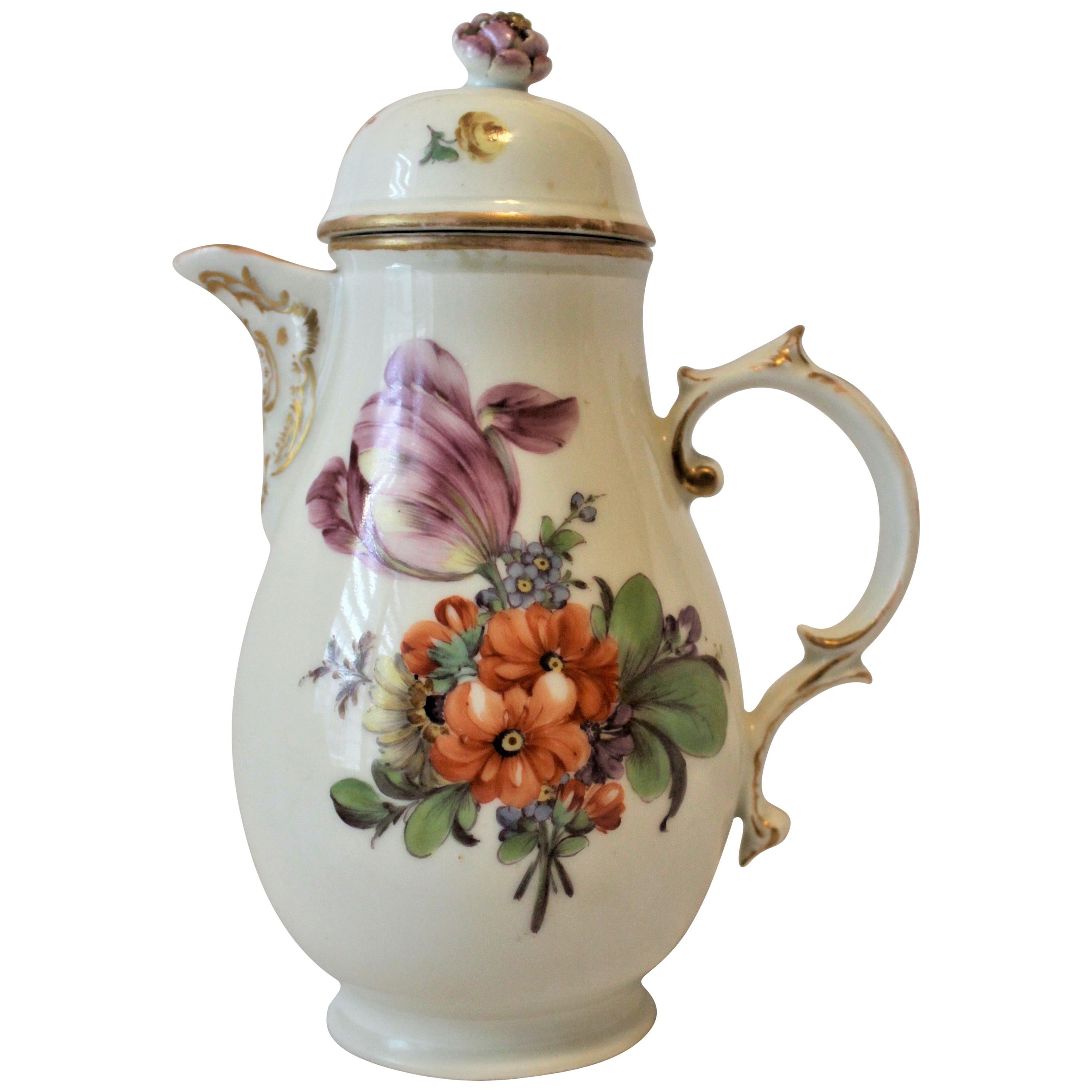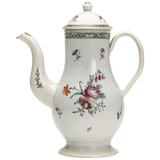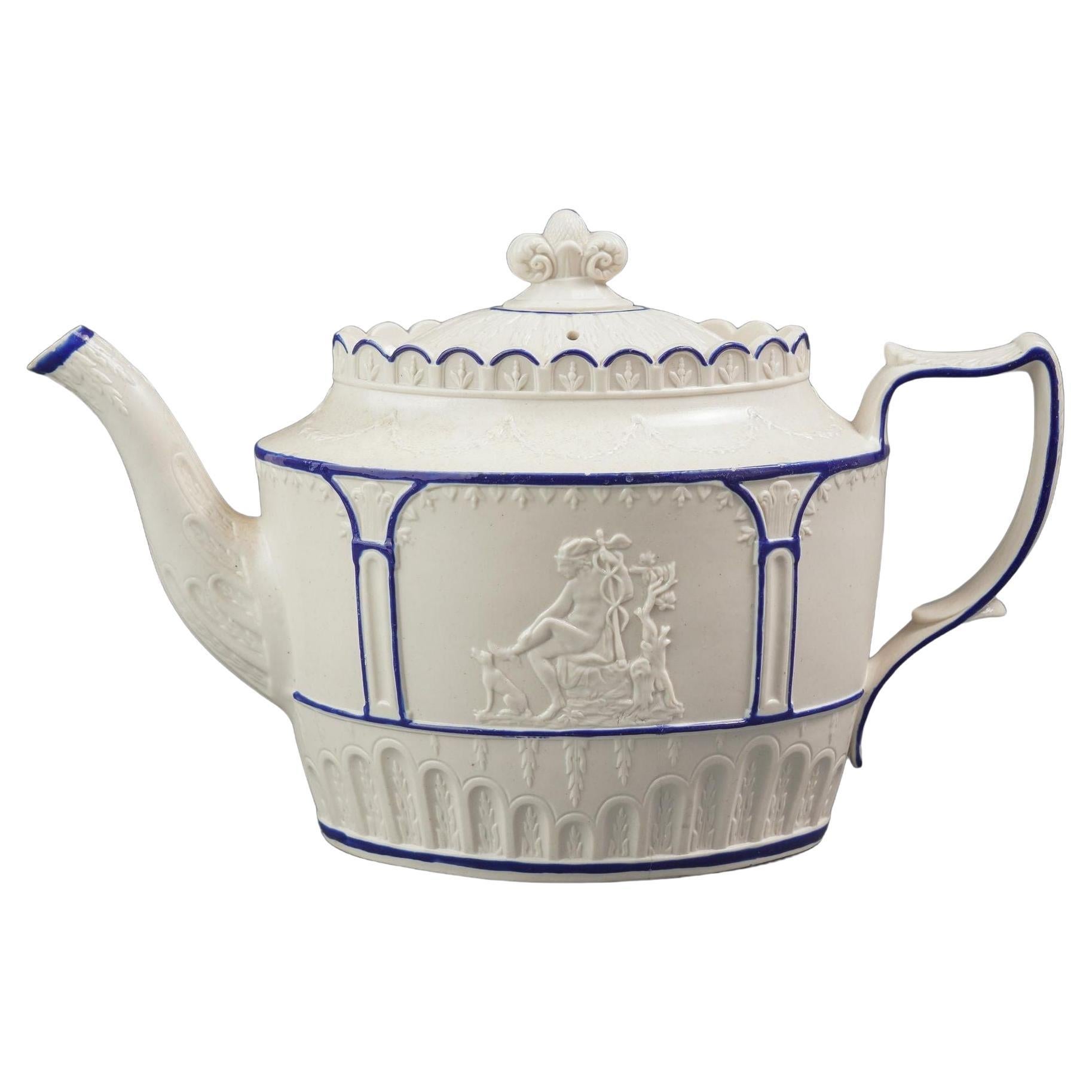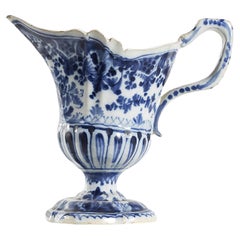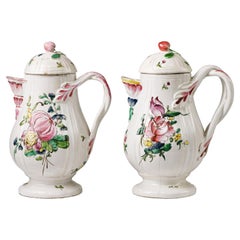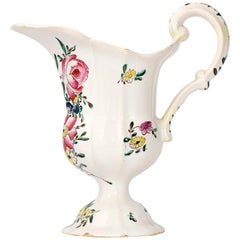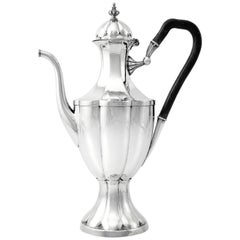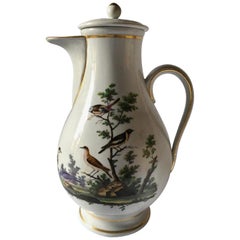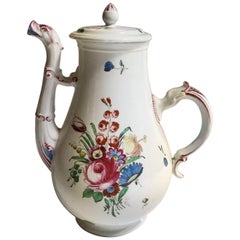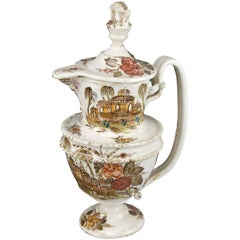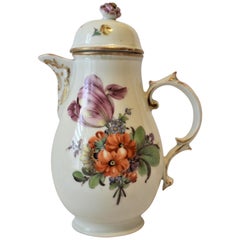Items Similar to Ancient Italian Coffee Pot, Coppellotti Manufacture, Lodi, Circa 1740
Video Loading
Want more images or videos?
Request additional images or videos from the seller
1 of 21
Ancient Italian Coffee Pot, Coppellotti Manufacture, Lodi, Circa 1740
$17,972.15
£13,376.62
€15,000
CA$24,617.36
A$27,379.88
CHF 14,296.92
MX$333,183.96
NOK 182,593.49
SEK 171,240.48
DKK 114,189.76
Shipping
Retrieving quote...The 1stDibs Promise:
Authenticity Guarantee,
Money-Back Guarantee,
24-Hour Cancellation
About the Item
Coffee pot
Antonio Maria Coppellotti Manufacture
Lodi, Circa 1740
High fire polychrome maiolica
It measures: 7.87 in x 6,49 x 5.11 (20 cm x 16,5 x 13); weight 1.23 lb (561 g)
State of conservation: the coffee pot is in excellent condition except for some chipping from use and some subtle, insignificant heat fêlures along the body. The lid has been restored.
The coffeepot, with an enlarged, ribbed, pyriform body and belly, rests on a barely visible flat foot. It has a beak pourer and shaped handle; the lid rises low above the body, is poded and surmounted by a button knob (restored).
The shape is typical of the works produced by the Lodi factories of the first half of the 18th century and is inspired by silverware models.
On the front of the container, the high-fire polychromy decoration shows a couple of figures dressed in "Turkish-style" on a clump of earth: there is a seated woman and a man standing between two small trees coming towards her.
On one side, on another clump of earth, you can see a building with towers and, on the other side, on two separate clumps, a fawn and a bird on the ground near some small trees. The composition is completed by insects and butterflies, some of which are painted on the handle. The lid, consistent in shape, bears an ornament with rocaille that is stylistically different from the rest of the composition.
The brand with the “AMC” monogram is painted under the foot and here it is also associated with the word "Lodi" in cobalt blue.
The coffee pot can be attributed with certainty, thanks to the brand mark, to the well-known Lodi manufacture of Anton Maria Coppellotti in the years around 1740. It was around this time that the factory abandoned the Baroque decorative canons for the new trends in fashion, including that of the “paesini e figure” (villages and figure), a style which catalogs a few and rare known examples of closed forms and a greater number of open forms (non capisco bene cosa volete dire per "closed and open forms").
The coffee pot was exhibited in the famous Lombard maiolica exhibition in 1964 (G. Gregorietti, Maioliche di Lodi, Milano e Pavia, catalogo della mostra, Museo Poldi Pezzoli, Milano 1964, n. 72) and still bears the display label under the base.
It also bears the label of Rodolfo Subert, antique dealer and great-grandfather of this writer, whose shop in Galleria Vittorio Emanuele II in Milan was destroyed by bombing in August 1943.
A comparative example, without a lid, is kept in the Musèe National de la Céramique in Sévres (inv. 02CE4592- 908511). Another one, also without a lid, is present in a private collection (Felice Ferrari, La ceramica di Lodi, Lodi 2003 p. 157).
The first mention of the Coppellotti family as potters comes from archival documents which record the official request of an unknown Giovanni Coppellotti to open a majolica factory in Lodi in 1674.
The factory, located near the church of St. Philip seems to have been immediately quite successful. However, it was only in 1679, when the management of the factory passed to Antonio Giovanni Maria Coppellotti – the son or perhaps grandson of the original Giovanni - that the production reached the peak of success and became an example for the main Italian manufactures of the time, especially those in Veneto and Liguria. In 1728 the factory had to move outside the city walls at the behest of the authorities, who feared the possibility of fires.
The activity continued until about 1750, the year of Anton Maria's death and resumed later with his son, Bassano Coppellotti, under the guide of some other directors, among whom we note: first, G. Moroni, followed by Giulio Berinzaghi and in 1771 Pedrinazzi. Finally, in 1787 a new municipal ordinance ordered the definitive closure of the manufactory.
The maiolica produced during the initial period are characterized by the use of a thick, velvety enamel and have ornaments ranging from monochrome turquoise with Italian (ruins, castles, flowers) and French motifs ("rabeschi", ramage), to decorations in the manner of Chinese porcelain and oriental inspiration.
Of particular importance are ornaments of Baroque fruit which show the amazing relief effects produced by using the red tone called "Armenian bolus". This great variety of decorations appeared between 1735 and 1740 by which time, alongside the production of turquoise monochrome, polychromy with high fire technique was firmly established. The brand precisely identifying the maiolica of this factory is rare and uses a woven "AMC" monogram. It was sometimes done in different colors and was sometimes accompanied by the names of the painters and modelers of the manufacture.
Bibliography:
C. Baroni, La maiolica antica di Lodi, in “Archivio storico lombardo” LVIII, 1930, pp. 448 s., 455-457.
A. Minghetti, I ceramisti italiani, Roma 1946, p. 129.
S. Levy, Maioliche settecentesche lombarde e venete, Milano 1962, pp. 15-17, tavv. 121-150.
G. Gregorietti Museo Poldi Pezzoli, Maioliche di Lodi, Milano e Pavia, catalogo della mostra, Milano 1964, n. 72.
A. Novasconi - S. Ferrari - S. Corvi, La ceramica lodigiana, Milano 1964, pp. 23, 27, 34-36, 47, ill. pp. 53-121.
O. G. C. Sciolla, Museo civico di Lodi, Bologna 1977, pp. VIII s.; tavv. pp. 72-76, 78.
M. L. Gelmini, Maioliche lodigiane del ‘700, Milano 1995.
Felice Ferrari, La ceramica di Lodi, Lodi 2003.
- Creator:Antonio Maria Coppellotti (Manufacturer)
- Dimensions:Height: 7.88 in (20 cm)Width: 6.5 in (16.5 cm)Depth: 5.12 in (13 cm)
- Style:Rococo (Of the Period)
- Materials and Techniques:Maiolica,Glazed
- Place of Origin:
- Period:1730-1739
- Date of Manufacture:circa 1740
- Condition:Repaired: The lid has been restored. The lid has been restored. The coffee pot is in excellent condition except for some chipping from use and some subtle, insignificant heat fêlures along the body.
- Seller Location:Milano, IT
- Reference Number:1stDibs: LU4352231338932
About the Seller
4.3
Vetted Professional Seller
Every seller passes strict standards for authenticity and reliability
Established in 1860
1stDibs seller since 2018
21 sales on 1stDibs
Associations
International Confederation of Art and Antique Dealers' Associations
- ShippingRetrieving quote...Shipping from: Milano, Italy
- Return Policy
Authenticity Guarantee
In the unlikely event there’s an issue with an item’s authenticity, contact us within 1 year for a full refund. DetailsMoney-Back Guarantee
If your item is not as described, is damaged in transit, or does not arrive, contact us within 7 days for a full refund. Details24-Hour Cancellation
You have a 24-hour grace period in which to reconsider your purchase, with no questions asked.Vetted Professional Sellers
Our world-class sellers must adhere to strict standards for service and quality, maintaining the integrity of our listings.Price-Match Guarantee
If you find that a seller listed the same item for a lower price elsewhere, we’ll match it.Trusted Global Delivery
Our best-in-class carrier network provides specialized shipping options worldwide, including custom delivery.More From This Seller
View AllMaiolica Pitcher Antonio Maria Coppellotti Manufacture, Lodi, Circa 1735
By Antonio Maria Coppellotti
Located in Milano, IT
Majolica pitcher
Antonio Maria Coppellotti Manufacture
Lodi, circa 1735
Majolica decorated in cobalt blue monochrome
It measures 7.36 in hight x 8.07 x 4.52 (h 18.7 cm x 20.5 x 11.5...
Category
Antique 1730s Italian Baroque Ceramics
Materials
Maiolica
Ancient Pair Coffee Pots, Pasquale Rubati Manufacture Milan, 1770 circa
By Pasquale Rubati
Located in Milano, IT
Pair of small coffee pots.
Manufacture of Pasquale Rubati
Milan, 1770 Circa
Maiolica polychrome decorated “a piccolo fuoco” (third fire).
a) height 7.87 x 5.51 x 3.93 in (20 x 14 x ...
Category
Antique 1760s Italian Neoclassical Ceramics
Materials
Maiolica
Italian Maiolica Pitcher, Ferretti Manufacture, Lodi Circa 1770 - 1780
By Antonio Ferretti
Located in Milano, IT
Maiolica pitcher
Antonio Ferretti Manufacture
Lodi, circa 1770-1780
Maiolica polychrome decorated “a piccolo fuoco” (third fire).
It measures 8.66 x 8.66 x 4.33 in (22 x 22 x 11 ...
Category
Antique 1770s Italian Rococo Ceramics
Materials
Maiolica
Ancient Neoclassic Sterling Silver Coffee Pot, Palermo, Sicily circa 1789
Located in Milano, IT
Ancient Neoclassic Sterling Silver Coffee Pot, Palermo, Sicily circa 1789
Embossed and engraved silver coffee pot
Silversmith, probably Agostino Natoli
Diego Di Maggio, Silversmith Consul in 1789 and 1796
Palermo, 1789
It measures 14.17 in (36 cm) high and weighs 2.76 lb (1.252 g)
State of conservation: few signs of use and some slight blemishes
The large silver coffee pot has a round mouthpiece with a markedly everted rim, on which hinges a domed lid with very full molded pod shapes; a closed bud surmounted by a small sphere serves as a knob. The polygonal neck descends and widens into molded elements that come together, with larger pods, at the point where it is attached to the body. The body in turn is united to a well-shaped foot, which ends in a flat base with a vertical rim.
From the body rises a spout with a circular mouth accented with a thick rim. An angled loop, made of ebonized wood, is applied to the neck by means of a double-cone element having a sphere at its center; it ends in a silver cone...
Category
Antique 1780s Sicilian Neoclassical Sterling Silver
Materials
Sterling Silver
Ancient Italian Assortment Coffe Pot and Cups, Lodi, Circa 1765-1770
By Antonio Ferretti
Located in Milano, IT
A coffee pot and two cups with saucers
Antonio Ferretti Manufacture
Lodi, Circa 1765-1770
Maiolica polychrome decorated “a piccolo fuoco” (third fire).
They measure:
coffee pot: 9....
Category
Antique 1760s Italian Rococo Ceramics
Materials
Maiolica
Large Italian Neoclassic Sterling Silver Coffee Pot, Milan, Circa 1830
Located in Milano, IT
Embossed and engraved silver coffee pot
Antonio Garavaglia
Milan, Circa 1830
It measures 16.92 in (43 cm) in height and weighs 3.35 lb (1.520 gr)
State of conservation: very good
The large silver coffee pot has a round mouthpiece with a marked everted rim on which a pagoda lid rests; this is surmounted by a cock-shaped knob with a border decorated with small pods...
Category
Antique 1820s Italian Neoclassical Sterling Silver
Materials
Sterling Silver
You May Also Like
Italy Richard Ginori Mid-18th Century Porcelain Coffee Pot
By Richard Ginori
Located in Brescia, IT
In this elegant coffee pot we can admire the elegant drawing with a natural landscape full of many specimens of birds.
Manufactured in circa 1750, the piece has its time but it is i...
Category
Antique Mid-18th Century Italian Baroque Porcelain
Materials
Porcelain
Italy 19th Century Richard Ginori Porcelain Coffee Pot with Flowers Decor
By Richard Ginori
Located in Brescia, IT
This is a beautiful piece in Italian porcelain handmade by Richard Ginori. The high quality of this italian production of Doccia, is recognizable at first glance. The flower decorati...
Category
Antique Early 19th Century Italian Baroque Porcelain
Materials
Porcelain
$2,204 Sale Price
20% Off
Villafeliche Jug, Aragon, Spain, 18th Century
Located in Madrid, ES
Late Baroque pottery jug made and decorated with high temperature glazes over a white slip of tin. These motifs are combined with enameled decorations in relief obtained mold. The typology of the piece combines Italian jug with handle ovoid belly and vertical bow, with the peak jug typically Spanish, characterized by the outgoing peak of the mouth. Decorations reveal the oriental influence, with large floral bouquets arranged asymmetrically and complex landscapes with architecture and palm trees, which remove some figures, such as totally Western. The reasons appear pincelados in manganese black, and colored with ocher, blue, green and red, mainly enamels. Aragon ceramic least a century old will be characterized by a strong own, combined with the influences of personality Talavera and Catalonia. You will have three main centers: Teruel, Muel and Villafeliche, the first two with tradition since the 16th century, and the third created in the late 17th century. The Villafeliche will generally be very popular ceramics...
Category
Antique 18th Century Spanish Neoclassical Ceramics
Materials
Ceramic
Antique German Furstenberg Porcelain Coffee Pot
By Furstenberg Porcelain
Located in Hamilton, Ontario
This antique German porcelain coffee pot was made by the Furstenberg Works factory in circa 1760 in the period Rococo style. This coffee pot is d...
Category
Antique Mid-18th Century German Rococo Porcelain
Materials
Porcelain
Antique Staffordshire Floral Painted Pearlware Coffee Pot 18th Century
Located in Bishop's Stortford, Hertfordshire
An antique Staffordshire pearlware coffee pot and cover hand-painted in coloured enamels with floral designs. This elegant and lightly potted coff...
Category
Antique 18th Century English Ceramics
Materials
Ceramic, Pearlware
English stoneware tea pot by Castleford, c. 1810
By Castleford Pottery
Located in Kenilworth, IL
Castleford smear glaze feldspathic stoneware covered tea pot with cobalt blue enamel striping and applied Classical decoration throughout.
English, circa 1810.
Category
Antique Early 19th Century British Tea Sets
Materials
Stoneware
More Ways To Browse
Coffee Container
Rococo Dress
Chinese Flower Pot
Antique Italian Pot
Italian Lombard
Blue Chinese Pots
Chinese Flower Pots
French Coffee Pots
Antique Bombs
Antique Italian Porcelain Flowers
French Silver Coffee Pot
Cobalt Blue Pots
Antique 1930s Dress Dresses
Italian Coffee Pot
Silver Enamel Butterfly
1930s Red Dress
Sevres China
Chinese Pots With Lids
